The best gardens are those that intentionally engage visitors by offering an element of surprise. The appropriate use of sculpture is an effective way to achieve this. We have all seen the usual array of concrete Asian lanterns, frogs and umbrella-toting children. Rusted steel, such as Cor-Ten, has earned its place as a sculptural medium in urban gardens but has almost become an expected element in those spaces.
How about something different, something with shine that brightens up a drab corner, that captures both the sun and the attention of your guests? I suggest taking stainless steel out of the kitchen and introducing it into the garden. Let’s look at stainless steel and its cousins to see how they can be used to give your garden sparkle.
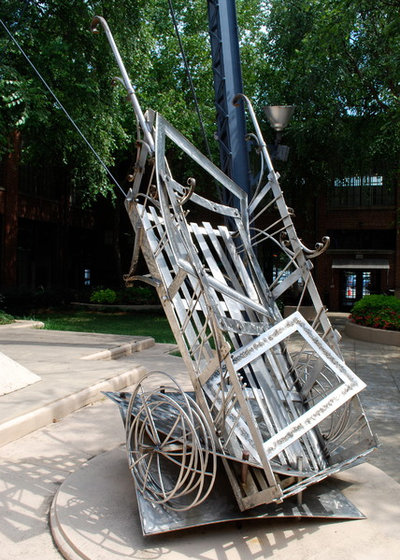
Jay Sifford Garden Design
Stainless steel is steel that contains a minimum of 10.5 percent chromium. Chromium combines with oxygen to create a thin oxide that protects the metal from rust, stains and weathering, explains Benjamin Parrish, a Charlotte, North Carolina, metal artist whose work is shown here.
As is the case with most metals, stainless can scratch. It is purchased by fabricators in bars, rods or sheets. These different forms can be used together to create unique pieces such as this one, which is a study in implied movement.
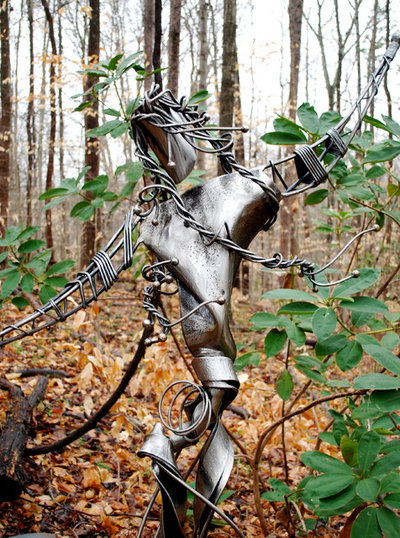
Jay Sifford Garden Design
Mild steel is an alternative to stainless that is more malleable and less expensive, says Parrish. This steel contains less than 0.25 percent carbon, which makes it easier to work. It can rust and stain; therefore it is generally sealed with epoxy or urethane, or even painted. Various oxides can be applied to mild steel to achieve a patina. This sculpture, formed out of mild steel by Parrish, beautifully reflects the morning light.
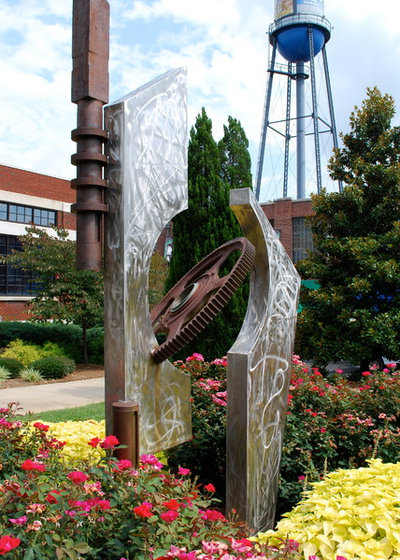
Jay Sifford Garden Design
Aluminum is an economical choice for outdoor metal sculpture, costing about 30 percent less than stainless steel. Parrish says that aluminum, like mild steel, is generally sealed and can be given a patina.
Various metals can also be combined in a single sculpture to create whimsy, contrast or interest. Here we see a piece that incorporates rusted pieces of machinery.
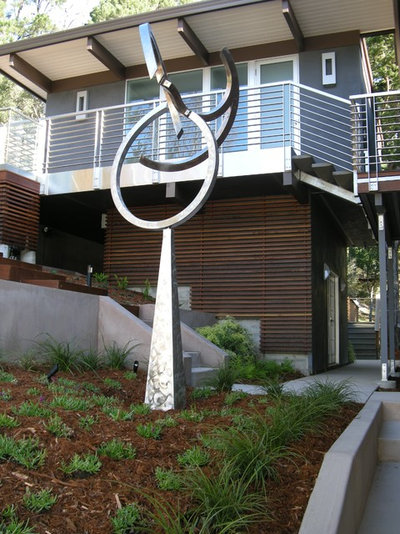
O'Connell Landscape
We generally think of steel as being most at home in industrial or contemporary environments. Notice how the sculptural piece shown here pulls the home’s stainless steel deck railing into the garden, creating a meaningful link between the two. The art establishes its own identity with its etched pattern, which was created with an angle grinder.
When selecting contemporary art, proper scale, leaning more toward the slightly oversize, is important. A tall structure like the home shown here could very easily overpower most garden art.
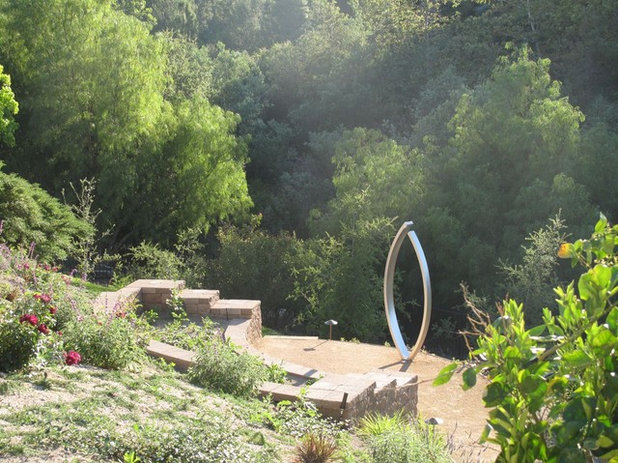
TerraSculpture
Metal sculpture is equally at home in informal woodland gardens. This stainless steel piece, by TerraSculpture, was cast in a larger size to match the scale of this expansive garden. The juxtaposition of the sculpture and the surrounding woodlands creates an element of surprise that lends itself to a philosophical mood.
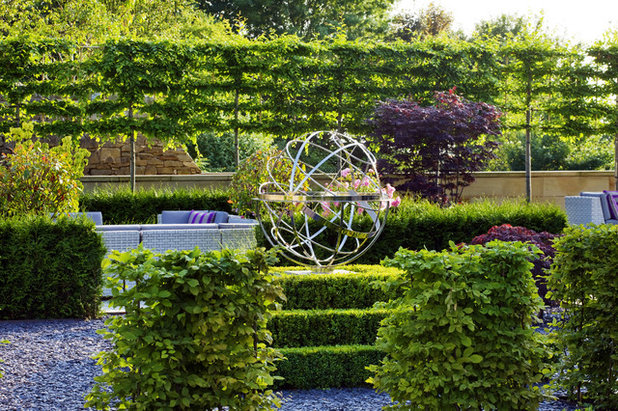
David Harber
Metal sculpture is even at home in formal and traditional gardens, as shown by this armillary sundial, by David Harber. This stainless piece reflects the sunlight in a remarkable way, lending a crisp, contemporary edge to this garden full of topiary and traditional lines.
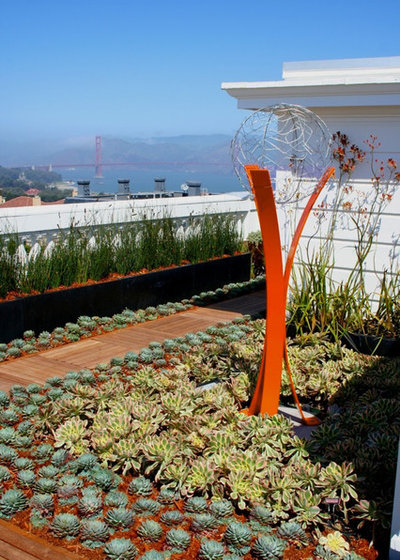
TerraSculpture
If your garden needs less sparkle and more color, consider artwork that combines stainless steel with powder-coated steel, such as the piece seen here, by TerraSculpture. With powder coating the color is applied as a dry powder that is electrostatically bonded to the metal, then cured with heat. It is more durable than paint but can still be scratched. It cannot be effectively touched up, says Parrish.
The sculpture in this garden mimics the color of the Golden Gate Bridge in the background, creating a link and a real sense of place.
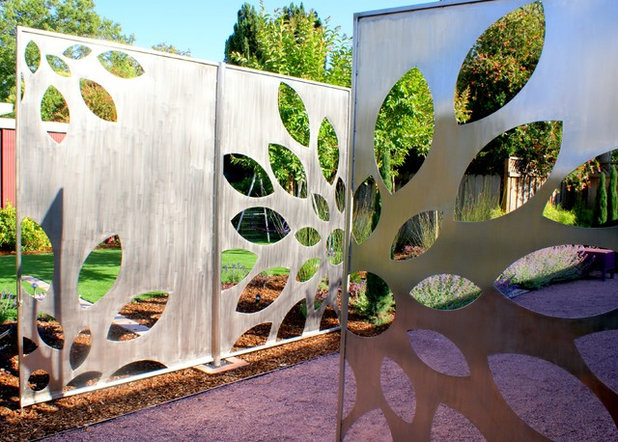
Zeterre Landscape Architecture
Not all garden bling is strictly decorative. Consider stainless steel for utilitarian purposes as well, such as with this gate. A gate like this is not intended to keep animals in or out, nor is it for privacy. It does, however, establish garden boundaries and does so with style.
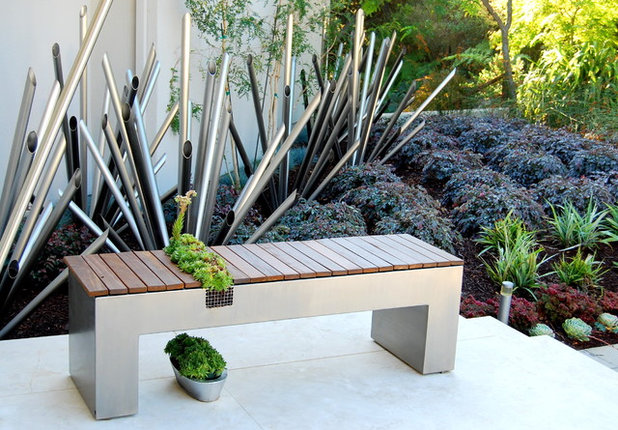
Zeterre Landscape Architecture
Stainless steel is virtually care free in most environments, as are properly sealed mild steel and aluminum. Stainless can discolor when exposed to an open flame. Additionally, constant exposure to salt in coastal environments can slowly react with the chromium in stainless steel, causing rust.
Stainless may be cleaned with a nonabrasive kitchen metal cleaner or a mild detergent solution. Mild steel and aluminum may need to be resealed every five to 10 years unless, as Parrish says with a smile, “rust is your friend.”
More: Give Your Garden an Industrial Edge





